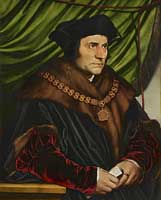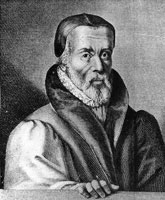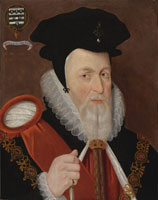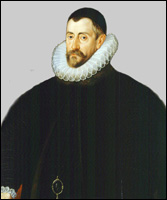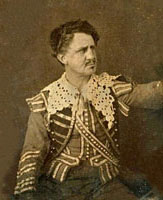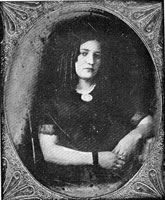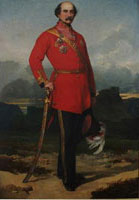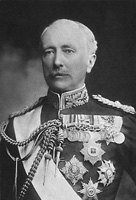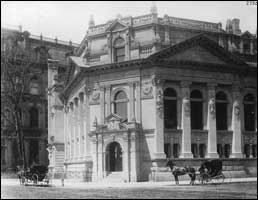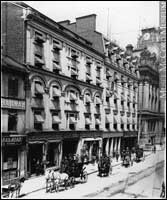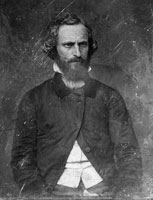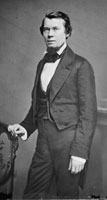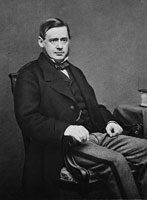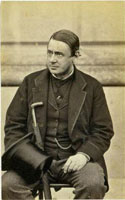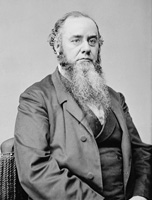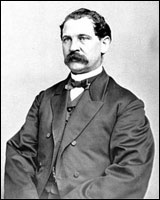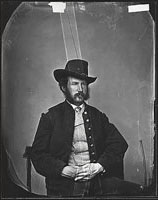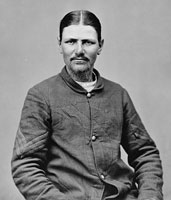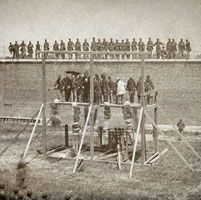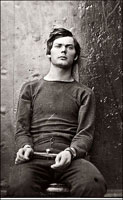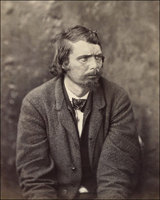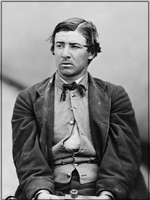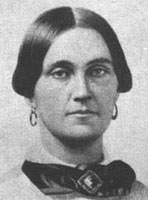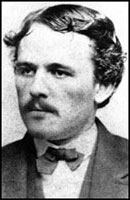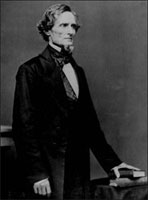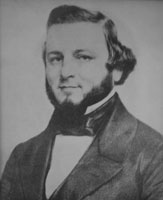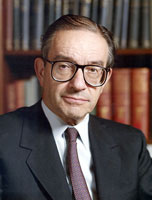The assassination of President Lincoln was one of the most sophisticated psyops or espionage operations in the entire history of the world. More sinister still, the subsequent cover-up provides no parallel for the enduring and ramifying pattern of concealment spun upon the crime at Ford's Theatre.
People very, very close to President Lincoln were used to lure him to the theatre. A bitter covert foe of Lincoln, and the most powerful man in Washington City at that time was Lincoln's very own Secretary of War, Edwin M. Stanton.
The British monarchy also had the motive because the American Revolution was all about delivering Israel in the Wilderness to the Spanish Inquisition. The British base of operations in the New World was Montreal, Canada.
British Counter-Reformation spying began with Sir Thomas More!!
Counter-Reformation spying began in England during the time of Sir Thomas More. More was a bitter foe of the Bible in English and his spies watched all ships coming into the country for "contraband" Bibles.
|
Saint William Tyndale was subsequently burned alive at the stake for translating the Bible into English. The British Secret Service was born in 1558 when Sir William Cecil appointed Sir Francis Walsingham as his chief "spymaster."
|
Theatre groups frequently toured the country known as the "Queen's Men" and this was a perfect cover for Walsingham's spies.
"Silversmith" Ricardo Botha alias Robert Booth!!
Booth's great-great-grandfather, Ricardo Botha–a Spanish Inquisition "Jew," arrived from Spain via Portugal around 1760 and changed his name to Robert Booth. Ricardo had unlimited funds from the slave labor silver mines of Mexico:
Turning back to discover the sort of timber that had gone into his making–since today a man may place a certain portion of responsibility on his ancestors for the kind of person he discovers in himself–it is very curious to trace the Booth line. Whether she obtained her information from Booth himself, or from members of his family, I do not know, but my grandmother always told us the family had come originally from Spain, and that the name was either Bethe or Botha. Ricardo Botha, she said, was a lawyer of Madrid, and a Spanish Jew, who wrote inflammatory pamphlets against the existing royalist government in the seventeenth century, and was banished, his property being confiscated. He settled with his family in Lisbon, Portugal, and continued to issue denunciatory writings. His wife was a Spanish lady, who followed him into exile with their son, Roberto. This son made his way to London, and pursued the calling of a silversmith, changing his name to Robert Booth. His son, John, in turn, followed the craft of his father, but evidently consorted with the freethinkers of his time. Among his neighbors in Clerkenwell, there lived the most erratic advocate and fighter for the rights of man and a free parliament in England, John Wilkes. (Forrester, This One Mad Act, p. 10).
"Silversmith" Ricardo coordinated the shipment of vast amounts of Spanish New World silver to London in order to finance the American Revolution.
John Wilkes and Sir Francis Dashwood were the driving force behind the American Revolution. Wilkes was a leading member of the Hellfire Club, or the Order of the Friars of "Saint" Francis of Wycombe, where top aristocrats (including Benjamin Franklin) met to plan the Revolution.
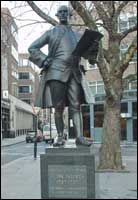 John Wilkes statue in London. |
|
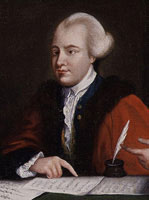 John Wilkes (1725–1797). |
The union of the "Booths" and Wilkes united Spanish silver and bribes with British brains and cunning. This deadly combination added a powerful weapon to the arsenal of the Counter-Reformation.
|
The aristocratic Junius Brutus Booth left his wife and child in England and came to the United States in 1821. This diehard monarchist had a sudden "conversion" to republicanism:
He told Mary Ann that all his life he had looked at a portrait of George Washington, and listened to his father expound the benefits to be derived from living in that great Republic across the sea. Often he had thought of going there; and, since it now offered more inducements than even his father had included in his eulogies, and since Providence had placed within their reach the very means of accomplishing that purpose, he suggested that they sail to the United States. There he could take care of her and plan for the future. Would she go with him? (Kimmel, The Mad Booths of Maryland. p. 30).
What a load of hogwash....Booth was nothing more or less than a British spy sent to destroy the great Republic across the sea by sowing dissension between North and South.
British spying from Canada became intense after Gettysburg!!
British spying against the U.S. became intense after the defeat of the Confederacy at the Battle of Gettysburg. With all hope of military intervention by their troop in Canada ended, they decided to use spying, sabotage, biological warfare, arson, and finally the assassination of President Lincoln.
Commanding the British forces in Canada was a gung-ho general named Sir William Williams and a lieutenant colonel named Garnet Wolseley. Williams and Wolseley gained their combat experience fighting with the Terrible Turks against the Russians in the Crimean War.
|
The general and the colonel were filled with rage and disappointment when Lincoln's deft diplomacy gave them no chance to intervene directly in the Civil War. Their next step was to arrange the transfer of 1 million dollars in gold from the Bank of England to the Bank of Montreal:
When the Confederate agents set up operations in Canada in May of 1864 they received a million dollars in gold from Confederate Secret Service funds to finance their operations against the United States. Some of this money may have been given to Booth while in Montreal to help underwrite his scheme to capture Lincoln. The fact that Booth returned from Canada and made a deposit in Cooke's bank within a week suggests that Martin had provided the funds. The amount of money was not trivial. In today's market, $1,500 is the equivalent of approximately $16,000 in current dollars. Booth disbursed all of this money between January 7 and March 16, the most active period of his recruitment activities, which further supports the notion that the funds were to support his capture plan. (Steers, Blood on the Moon, p. 73-74).
A lot of the gold came from the sale of Southern cotton in England.
|
Montreal was known as "Little Richmond" and the conspirators had virtually unlimited funds from the Bank of England.
|
Booth arrived in "Little Richmond" in October 1864 and a covert war of unprecedented scale began against the United States:
Upon his arrival, Wilkes immediately got in contact with these Secessionists. Among them were Jacob Thomson, controller of the Confederate bank account in Canada, Clement C. Clay, Beverly Tucker, George N. Saunders, Dr. M. A. Pallen, a Dr. Blackburn of Kentucky, a Mr. Lee from Virginia (related to General Robert E. Lee), J. D. Wescott of Florida (whose sitting room in suite number four was their meeting place), and several others. Wilkes was not secretive about connections. He thought it flattering to be seen openly with such men, drinking wine at their tables, and appearing on familiar terms with them. As they seldom had anything to do with persons outside their own clique and were known to be plotting against the Union this intimacy aroused the suspicions of other guests and Wilkes was questioned by a few of his former acquaintances. (Kimmel, The Mad Booths of Maryland. p. 188).
Wilkes arrived back in New York in November and bought 2 carbines, 3 pairs of revolvers, 3 daggers and 2 pairs of "handcuffs" to "abduct" the President. No intelligent person could propose such a scheme because by now the British wanted the President dead . . . dead . . . dead!!
The British ambassador left Washington City just before the assassination!!
In December 1864, the British ambassador to the U.S., Richard Bickerton Pemell Lyons, got a sudden "headache" and left the country. Lyons did not want to be around to shed crocidile tears after the assassination.
The taciturn, laconic Lyons hated the United States with a passion, was unmarried, and was most likely a Jesuit priest in disguise.
|
Here is a copy of a dispatch from Lord Lyons to his boss in London, Lord John Russell:
Lord Lyons to Lord Russell.
Washington, Dec. 5,1864.
I am truly obliged to you for so promptly sending me leave to come home. When I wrote to you on the 1st of last month to ask for it, I hardly expected to have such urgent need of it as I have now, but a few days afterwards I became so ill as to be utterly unable to do any work. I have not made any satisfactory progress towards a recovery, and am scarcely in a state to travel. There seems however to be no prospect of my getting any better if I stay here, and I shall therefore, if possible, set out for New York to-morrow, in the hope of being able to embark there for England on the 14th.
I am told that the American papers have stated that I have been dangerously ill with typhoid fever. I have had no fever at all. My principal malady is a nervous headache. (Lord Newton, Lord Lyons: A Record of British Diplomacy, p. 136).
Unfortunately, Lord Lyons did not close the embassy and take his staff with him. The embassy continued to be a liaison between "Little Richmond" in Canada and Jefferson Davis. The embassy staff also worked closely with Secretary of War Edwin M. Stanton. The new ambassador, Sir Frederick Bruce, did not arrive until after the assassination.
|
Rumors were everywhere that night that something terrible was about to happen to the President, but Mary Lincoln insisted that her husband accompany her to the theatre.
Eckert was busy indeed that night because the telegraph shut down for 2 hours between 10 p.m. and 12 midnight:
A bizarre incident on the night of April 14 was an interruption of all telegraphic communication between Washington and the outside world, lasting about two hours."Within fifteen minute; after the murder," wrote Townsend in the New York World on May 2, "the wires were severed entirely around the city, excepting only a secret wire for government uses, which leads to Old Point, I am told that by this wire the government reached the fortifications around Washington, first telegraphing all the way to Old Point, and then back to the outlying forts. This information came to me from so many creditable channels that I must concede it." (Eisenschiml, Why Was Lincoln Murdered, p. 78).
Even without a proper bodyguard for the President, Mary Lincoln still insisted that her husband accompany her to the theatre.
This delay in telegraphing the identity of the assassin allowed Booth to escape. If all went according to plan, Booth would have taken a ship down the Potomac River and then a steamer to Canada. His broken ankle upset his plans completely.
The "Booth" shot in the barn myth!!
The myth of Booth dying at the Garrett Farm is as absurd as Hitler committing suicide in the Führerbunker just after getting married. Britannia has always taken good care of her spies.
Lafayette C. Baker followed James William Boyd and David Herold to the Garrett farm. A squad of the 16th New York Cavalry, commanded by Captain Edward P. Doherty, surrounded the barn calling for "Booth" to come out.
Of course, there was no man named Booth in the barn. David Herold emerged from the barn and he was taken alive but Boyd was shot in the back of the head.
|
Reliable sources say that there were 3 men in the barn that night. The mystery man shot Boyd in the back of the neck and then escaped through a secret opening in the back of the barn.
To assure the success of the cover-up a "school for perjury" was set up in Washington's National Hotel where witnesses were coached on how to testify for Stanton against the defendants.
A "kangaroo court" sentenced 3 men and 1 woman to death!!
The strong conspiracy involved hundreds of people from the White House to the common sentry soldier but only 8 eventually were arraigned before a "kangaroo court." They were Samuel Arnold, George Atzerodt, David Herold, Samuel Mudd, Michael O'Laughlen, Lewis Powell, Edmund Spangler and Mary Surratt.
The man hanged as "Lewis Powell" was in reality Lewis Paine, a lay Baptist preacher!!
|
The man hanged as "Lewis Powell" was a look-alike of Lewis Paine. Paine was arrested 2 days after the assassination when he visited the home of Mary Surratt in Washington City. It never occurred to the military tribunal that a man wanted for murder would not try and escape the scene of the crime.
|
Mary Surratt was the first woman to be hanged in the United States. She was also a devout member of the Latin Church. She was convicted mostly on the testimony of Louis Weichmann. Weichmann was studying to be a priest and he certainty was of the same faith as Mary Surratt.
|
Mary Surratt was accompanied to the scaffold by a priest who administered the Latin last rites to her. Whether she wanted to kidnap the President or kill him, only the day of judgment will reveal.
An appeal for clemency by the kangaroo court to President Johnson never reached him or he was drunk at the time and ignored it.
As a result of her hanging, the Radical Republicans were blamed for her death.
The 2 top Confederates were never charged with any crime!!
Jefferson Davis was arrested in Georgia in May 1865, and imprisoned in Fortress Monroe on the coast of Virginia. Davis was imprisoned for 2 years but was released on $100,000 bail in 1868.
In July 1868, President Johnson issued a blanket pardon to all Confederates and thus Davis was never brought to trial for his part in the assassination.
Benjamin escaped to Florida and then crossed the ocean from there. It was rumored that he took most of the Confederate gold to England. Obviously, he was never extradited from Britain and his day in court will certainly take place at the Judgment Seat of Christ.
|
Judah P. Benjamin used the disguise of "Jew" instead of actor when he came to the United States in 1813. If he had ever opened the Jewish book called the Holy Bible he would have learned quickly that spies are DESPICABLE!!
British Columbia wanted to be part of the United States in 1866!!
Had President Lincoln lived, he surely would have enforced the Monroe Doctrine and allowed the British to withdraw from Canada gracefully.
When Secretary of State Seward was negotiating with Russia for the purchase of Alaska, the U.S. government expected that the British government would give British Columbia to the U.S. as compensation for all the destruction wrought by the Alabama:
Most newspapers in April 1867 supported the proposed purchase of Russian America. The New York Herald praised the agreement, especially because it increased the likelihood that the United States would acquire British Columbia. The Daily Alta California declared that it is of the highest importance to the whole country, and to the interests of this Coast particularly, that the territory should be consolidated as soon as possible. The Stars and Stripes should fly without rival from Behring's Straits to Cape St. Lucas," that is, to the southern tip of Baja California. The Chicago Tribune, although it almost always opposed Johnson and Seward, nevertheless favored the treaty. Many papers emphasized the treaty would strengthen the relationship between the United States and Russia. The National Republican declared that "if this country had a national friend it has been Russia," and commended the way in which the treaty would bring the two nations into friendly contact in the North Pacific, calling it "the greatest diplomatic achievement of the age. (Stahr, Seward: Lincoln's Indispensable Man. p. 488).
The name British Columbia is an oxymoron . . . It should be called British Zarco....The intelligent people of British Columbia wanted to become part of the United States in 1866:
At the outset of 1867, British Columbia was a struggling colony stretching from Washington territory to Russian America, with a population of only about 10,000 people. Many of the residents were unhappy with the colonial administration and hoped to become part of the United States. The American consul at Victoria, the main town of the colony, wrote to Seward in late 1866 that the locals were "almost unanimous in their desire for annexation to the United States." A Victoria newspaper, reprinted in the New York Times, claimed in early 1867 that "nine out of every ten of our people–sick of the present misrule–look to annexation to the United States as the only hope for our Colony. (Stahr, Seward: Lincoln's Indispensable Man. p. 497).
The British government strengthened her grip on Canada by passing the British North America Act:
The possible trade of the Alabama claims for British Columbia was in the newspapers on both sides of the Atlantic. The Times of London reported in May 1867 that "Secretary Seward has his eye on British Columbia and desires to obtain it." A complicating factor arose, however: the Canadian Confederation. The British North America Act, signed in March and effective in July 1867, created a national government for four eastern provinces, including Quebec and Ontario, and these eastern provinces started to "reach out" to British Columbia, inviting it to join them. A Montreal newspaper insisted in May that the new confederation must stretch from ocean to ocean, just like the United States. A Victoria paper predicted at about the same time that, in order to entice British Columbia, the new confederation would agree to assume the colony's substantial debts (Stahr, Seward: Lincoln's Indispensable Man. p. 499).
A British military and spying base stretching from ocean to ocean is SUICIDE for the United States. Since President Lincoln, no U.S. President has had the GUTS to enforce the Monroe Doctrine. New World people should govern themselves without any interference from the corrupt Old World....Likewise, New World people should stop interfering in the politics of the corrupt Old World....Our great JEHOVAH surrounded the New World with 2 vast oceans for a very good reason.
British spying against the U.S. is an intense as ever!!
Back in the Victorian era, before the Reformation was totally destroyed in Britain, spying was considered despicable, ungentlemanly, ill-bred, uncourtly, dishonest, underhanded etc., etc. Spies were indeed covert and foreign spying came under the jurisdiction of the Secretary of State for Foreign Affairs.
International spying came out of the closet in 1908 with the creation of MI6. Here is a very, very short list of very prominent people who have spied for . . . or are still spying for President Lincoln's assassins.
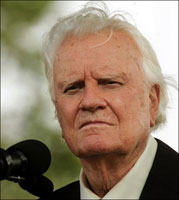 "Sir" Billy Graham (b. 1918). |
|
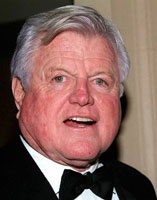 "Sir" Edward Kennedy (1932–2009). |
Unless it came with a flame-retardant suit, that pompous title is no good to him now.
British Counter-Reformation spying does not overlook any area of society: military, business, political, financial, entertainment, "education", sports etc., etc. all come under Britannia's soggy umbrella.
Representing the financial and entertainment worlds we have Alan Greenspan and Stephen Spielberg.
|
|
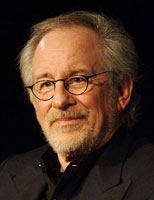 "Sir" Stephen Spielberg (b. 1946). |
Hollywood has always been a bastion of British spying with "stars" like Charlie Chaplin, Errol Flynn, Bob Hope etc., etc. I like to call entertainers the "Titanic orchestra."
Facebook could not contain all the faces that have spied for . . . or are still spying for Gog and Magog....True Christians should not be alarmed by this at all because it is a marvelous fulfillment of Bible prophecy:
And he (Antichrist) shall plant the tabernacles of his palace between the seas in the glorious holy mountain; yet he shall come to his end, and none shall help him (Daniel 11: 45).
The Exodus is a marvelous type of Armageddon and the end of the world. When the Egyptians were pursuing the children of Israel at the Red Sea, JEHOVAH sent his MECHANIC-ANGELS to pull off the wheels of their chariots–in order to slow them down:
And it came to pass, that in the morning watch that JEHOVAH looked unto the host of the Egyptians through the pillar of fire and of the cloud, and troubled the host of the Egyptians, and took off their chariot wheels, that they drove them heavily: so that the Egyptians said, "let us flee from the face of Israel; for JEHOVAH fighteth for them against the Egyptians" (Exodus:14:24-25).
In these last days . . . we cannot stop . . . but only slow down . . . Pharaoh's last mad suicidal charge . . . until all who trust in Christ alone for salvation have crossed the Red Sea–hallelujah!!
Vital links
References Balsiger, David & Sellier. Charles E. The Lincoln Conspiracy. Schick Sunn Classic Books, Los Angeles, California, 1977. Bates, David Homer. Lincoln in the Telegraph Office. University of Nebraska Press, Lincoln Nebraska, 1995.(Originally published in 1907). Baker, Lafayette C. History of the United States Secret Service. L.C. Baker, Philadelphia, 1867. Eisenschiml, Otto. Why Was Lincoln Murdered? Grosset & Dunlap, New York, 1937. Eisenschiml, Otto. In The Shadow of Lincoln's Death. Wilfred Funk, Inc., New York, 1940. Evans, Eli N. Judah P. Benjamin: The Jewish Confederate. The Free Press, New York, 1988. Forrester, Izola. This One Mad Act. Hale, Cushman & Flint, Boston, MASS, 1937. Foreman, Amanda. A World on Fire: Britain's Crucial Role in the American Civil War. Random House, New York, 2010. Good, Timothy Sean. We Saw Lincoln Shot. University Press of Mississippi. Jackson, Mississippi, 1995. Guttridge Leonard F. & Neff, Ray A. Dark Union: The Secret Web of Profiteers, Politicians & Booth Conspirators That Led to Lincoln's Death. John Wiley & Sons, Inc., Hoboken, NJ, 2003. Hanchett. William. The Lincoln Murder Conspiracies. University of Illinois Press, Urbana, 1983. Haynes, Alan. Walshingham: Elizabethan Spymaster and Statesman. Sutton Publishing, Gloustershire, UK, 2007. Johnson Clint. "A Vast and Fiendish Plot" The Confederate Attack on New York City. Citadel Press, New York 2010. Kimmel, Stanley. The Mad Booths of Maryland. The Bobbs-Merrill Company, Indianapolis, Indiana,1940. Lord Newton. Lord Lyons: A Record of British Diplomacy (in 2 volumes). Longmans, Green, & Co., New York, 1913. Mores, Jhon T. Diary of Gideon Welles: Secretary of the Navy Under Lincoln & Johnson. (in 3 volumes). Houghton Mifflin Co, Boston, MASS, 1909. O'Reilly Bill, & Dugard, Martin. Killing Lincoln: The Shocking Assassination that Changed America Forever. Henry Holt & Co., New York, 2011 Steers, Edward Jr. Blood on the Moon: The Assassination of Abraham Lincoln. University Press of Kentucky, Lexington, Kentucky, 2001. Shelton Vaughan. Mask for Treason—The Lincoln Murder Trial. Stackpole Books, Harrisburgh, Pennsylvania, 1965. Stahr, Walter. Seward: Lincoln's Indispensable Man. Simon & Schuster, New York, 2012. |
Copyright © 2013 by Patrick Scrivener
